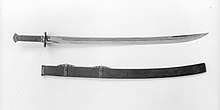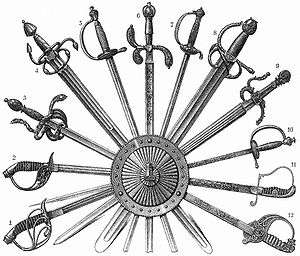Liuyedao
The liuyedao or willow-leaf saber is a type of dao that was commonly used as a military sidearm for both cavalry and infantry during the Ming and Qing dynasties. A decedent of the earlier Mongol saber the liuyedao remained the most popular type of single handed sabre during the Ming Dynasty, replacing the role of the military role of the Jian.[2] Many schools of Chinese martial arts originally trained with this weapon.[2]
| Liuyedao | |||||||||||||
|---|---|---|---|---|---|---|---|---|---|---|---|---|---|
 A 17th–18th century liuyedao with gilt iron fittings at the Metropolitan Museum of Art[1] | |||||||||||||
| Traditional Chinese | 柳葉刀 | ||||||||||||
| Simplified Chinese | 柳叶刀 | ||||||||||||
| Literal meaning | willow leaf knife | ||||||||||||
| |||||||||||||
This weapon features a moderate curve along the length of the blade. This reduces thrusting ability (though it is still fairly effective at same) while increasing the power of cuts and slashes. The hilts are typically straight, but can be re-curved downward starting in the 18th century.[3] It weighs from two to three pounds, and is 36 to 39 inches long.
Many examples will often have a decorated collar at the throat of the blade called a tunkou, which are stylistic holdovers from the preceding Mongol designs.[2]
References
Notes
- Tom 2001, pp. 217–219.
- Tom 2005, pp. 77-78
- Tom, Philip (2019). "Of Geese and Willows". Mandarin Mansion.
Sources
- Tom, Philip M. W. (2001). "Some Notable Sabers of the Qing Dynasty at the Metropolitan Museum of Art". Metropolitan Museum Journal. 36: 11, 207–222. doi:10.2307/1513063.CS1 maint: ref=harv (link)
- Tom, Philip with Scott M. Rodell (February 2005). "An Introduction to Chinese Single-Edged Hilt Weapons (Dao) and Their Use in the Ming and Qing Dynasties". Kung Fu Tai Chi, pp. 76–85
